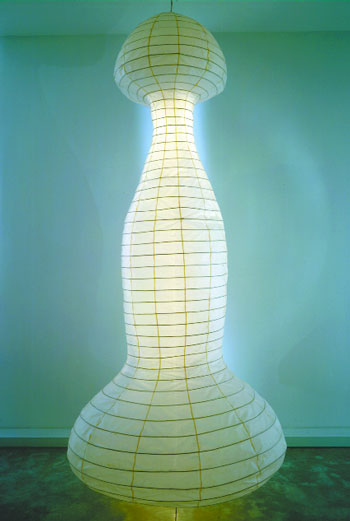Cheim and Read surveys 37 years of Lynda Benglis’ sculpture work
To provide a sense of the amazing breadth of Lynda Benglis’ sculptural vocabulary, here are some of the things the work in her small survey spanning 37 years now on view at Cheim and Read look like—giant silver dental fillings from outer space (“Nine Spot Field”); a translucent frozen, plastic, or crystal brain (“Hot Spot”); a surging, cresting Pacific wave frozen in bronze (“Cloak-Wave/Pedmarks”), a coiled Indian snake (“Nuestra Señora”), a hot fudge sundae (“Hohota”), a wild mushroom, penis, or the winged Nike of Samothrace (“Bolero”); tied silver intestines tacked to the wall (“Yankee”); a goldleafed segment of classical drapery (“Kajal”); piles of alien dung slung into a corner (“Quartered Meteor”); an encaustic cave formation (“Embryo II”); melted globs of day-glow colored silly putty (“Night Sherbert A”); and a suspended aluminum hydrant overflow (“Wing”).
Some of her influences (either way) include Bryan Hunt, Juan Muñoz, Richard Serra, Jackson Pollack, Polly Apfelbaum, Ken Price, Roxy Paine, and Eva Hesse.
Benglis emerged in the late 60s with her large-scale spills, which were created by pouring overlaid streams of brightly pigmented latex. These luscious floor pieces took off from the horozontality of Jackson Pollack’s drip paintings, except Benglis left hers on the floor. This innovation opened the door for an entire generation of installation artists, interested primarily in getting art off the wall and liberating it from its traditional frames.
Not surprisingly, Benglis’ approach shared many common concerns with feminism. Benglis interjected much needed visceral, colorful, and playful elements into the otherwise starkly bravado conceptualism of those days. Along with Eva Hessa, she helped balance the heavy austerities of Richard Serra before he went all curvy on us.
The exhibition starts off with a pun. The first work you see when you walk into the gallery looks like a large suspended Chinese lantern shaped in the form of a nuclear cloud, a silhouetted pin-up, or a dildo. Lit from the inside by a soft light, this glowing piece titled “Bikini Incandescent Column” is a subtle performance of gender fucking. Benglis conflates, formally, a phallus with feminine curves and, semantically, Bikini Island with a bikini swimsuit. She also nods to her own personal history with gender fuck, when she appeared naked in 1974 in the pages of Artforum holding an impressive dildo between her legs and—not completely unwittingly—ignited a controversy.
Her more subtle work is arguably the strongest. Perhaps free from the performative dialectical pressures of her more provocative statements, these works provide her a space—a room of her own—to engage in more intimate, lyrical forms, which are nothing less than poetic. This intimacy comes through most clearly in the early brushed wax pieces from the 60s and in her ceramic work from the 90s. The wax pieces resemble strange biological samples found deep within an unexplored cavern. They hint appropriately at the incipient stages of a great organic project.
The show’s two ceramic pieces—“Nuestra Señora” and “Hohota”—reveal an artistic maturity, wherein gooey, visceral forms are executed seemingly effortlessly with unmitigated playfulness, solid confidence, and great formal mastery over her materials.
This survey reveals in a bite-sized portion Benglis’ impact on an entire period of art history. Moreover, it’s a visual delight and like any significant exhibition, it offers a portal into another parallel universe, one where things that seem to flow, melt, slide, bend, and coil are paradoxically solid, and one where the separate realms of painting and sculpture almost merge. It’s Wonderland at Cheim and Read.



































